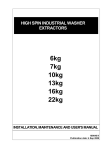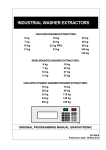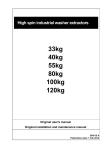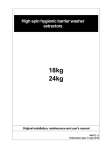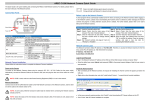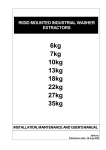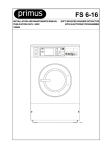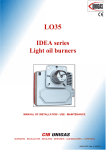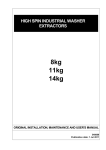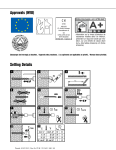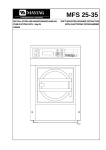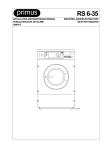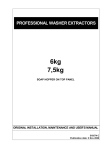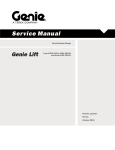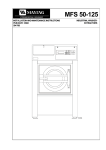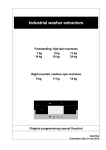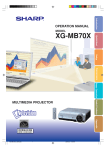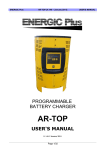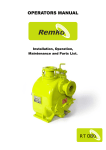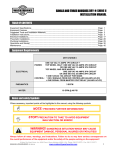Download 16kg 26kg 33kg 44kg 66kg
Transcript
HIGH SPIN HYGIENIC BARRIER WASHER EXTRACTORS 16kg 26kg 33kg 44kg 66kg ORIGINAL INSTALLATION, MAINTENANCE AND USER'S MANUAL 508636 K Publication date: 13 Jan 2012 USER'S MANUAL 1. TABLE OF CONTENTS 1. TABLE OF CONTENTS............................................................................................... 1 2. WARNINGS AND LABELS ......................................................................................... 2 2.1. INSTRUCTIONS FOR MAINTENANCE, ADJUSTMENT AND SAFETY OF PEOPLE ..........................3 3. SYMBOLS ON THE MACHINE (DEPENDING ON THE MACHINE MODEL)............. 4 4. OPERATING INSTRUCTIONS .................................................................................... 6 4.1. BEFORE WASHING................................................................................................................................6 4.2. PROGRAM SELECTION.........................................................................................................................9 4.3. WASH PROGRAMS OVERVIEW ...........................................................................................................9 4.4. ADD DETERGENTS..............................................................................................................................10 4.5. START THE WASHER EXTRACTOR...................................................................................................10 4.6. END OF WASH CYCLE ........................................................................................................................10 4.7. HOW TO OPEN DOOR WHEN FAILURE OCCURS............................................................................10 5. FIRST SERVICE AT TECHNICAL PROBLEM .......................................................... 11 508636_K_PUB_DATE_13_JAN_2012.DOC USER’S MANUAL 1 2. WARNINGS AND LABELS TO MINIMIZE THE RISK OF FIRE, INJURY BY ELECTRIC SHOCK OR SERIOUS INJURIES TO PEOPLE OR PROPERTY DAMAGE, PLEASE READ AND FOLLOW THE FOLLOWING INSTRUCTIONS: – This English version is original language version. Without this original version, these instructions are incomplete. – Before installation, operation and maintenance of the machine read carefully the complete instructions, i.e. this „Installation, maintenance and user's manual“, „Programming manual“ and „Spare parts manual“. The Programming manual and Spare parts manual are not delivered with a machine by default. You shall ask the supplier / manufacturer to obtain Programming manual and Spare parts manual. – Follow the instruction written in manuals and keep the manuals in a proper place by the machine for later use. – The washer extractor is designed for fabrics washing only, other objects can damage the machine and can cause damage or injuries. – The manufacturer is not responsible for the damage to the fabrics that are washed by an inappropriate washing method. – Always follow instructions and/or warnings that are stated on the fabrics, washing products or cleaning products mentioned by the manufacturer. – If the machine is used for special applications follow the instructions and warning to avoid person injury. – Keep the washer extractor surface and surrounding clean and free of flammable materials. – Do not put fabrics treated with flammable products in the washer extractor. Such fabrics must first be washed by hand and air dried. – Store laundry aids, dry-cleaning solvents and disinfectants out of the reach of children, preferably in a locked cabinet. – Do not tamper the washer-extractor controls and follow the safety instructions and the warnings. – Do not remove warning signs placed on the machine. Follow instructions on signs and labels to avoid personal injuries. – Do not use some means on the soap dispenser lid to hold it open by filling or when the machine operates. The discharge or splashing of hazardous liquid can cause serious scalding and burning. – The use of hypochlorite will cause corrosion which may cause component failure under certain circumstances. – The warranty of the machine cannot be accepted in case corrosion was caused by chlorine and chlorine compounds impact. – Do not operate the washer extractor when parts are broken or missing or when covers are open. The machine must not be operated until the fixed guards are put correctly in place. – The washer extractor is not designed for work which may create an explosive atmosphere inside the machine and will not be used for this purpose. – In case of steam escaping anywhere in the machine, shut off the main steam supply valve and call for maintenance. – Under certain conditions, hydrogen gas may be created in the hot water system that has not been used for two or more weeks. Hydrogen gas is explosive. If the hot water system has not been used for such period, open all hot water taps and let the water run out for few minutes. This will release any accumulated gas. As this gas is flammable, do not smoke or use open flames during this time. – In case of danger turn off the main switch or other emergency disconnection devices. – Turn off the main water supply at the end of each operating day. – Only qualified service personnel can execute service on the washer extractor. – Follow all valid and basic safety rules and laws. – It is obvious that it is impossible to mention each possible risk in this manual. It is up to the user to proceed as careful as possible. – The manufacturer reserves the right to change the manuals without previous notice. – If a problem should arise, contact your dealer for assistance. ! WARNING! IF THE INSTALLED APPLIANCE OPERATE WITH COIN, TOKEN OR SIMILAR OPERATION FOR USE IN SELF-SERVICE SITUATIONS, THEN THE OWNER-INSTALLER MUST PROVIDE A REMOTE-LOCATED EMERGENCY STOP DEVICE. THIS DEVICE MUST BE PLACED IN SUCH A WAY THAT IT IS EASY AND SAFELY ACCESSIBLE FOR THE USERS. THE EMERGENCY STOP DEVICE TAKES CARE THAT AT LEAST THE CONTROL CIRCUIT OF THE APPLIANCE IS INTERRUPTED. ! WARNING! DO NOT TOUCH THE DOORGLASS UNTIL CYCLE HAS BEEN COMPLETED. DO NOT OPEN DOOR UNTIL CYLINDER REMAINS STOPPED AND WATER HAS BEEN DRAINED FROM CYLINDER. DO NOT PUT ARTICLES SOILED WITH EXPLOSIF SOLVENTS AND/OR DANGEROUS CHEMICAL PRODUCTS IN THE MACHINE. THIS MACHINE SHOULD NOT BE USED BY CHILDREN. DO NOT LET CHILDREN PLAY IN, ON, OR AROUND THE MACHINE. BEFORE TURNING THE MACHINE „ON“, MAKE SURE THAT THERE ARE NO PEOPLE OR ANIMALS PRESENT IN OR AROUND THE MACHINE. 2 USER’S MANUAL 508636_K_PUB_DATE_13_JAN_2012.DOC WARNING! Always disconnect the washer from the electrical supply before attempting any service. The washer extractor is out of tension if the main plug is taken out or when the main supply is disconnected. When the main switch is turned off the inlet terminals of the machine main switch are still under current! CAUTION! Extreme hot conditions can arise in the surroundings of this air. Watch out for vapor that escapes from the washer extractor venting! CAUTION! Do not cover the washer extractor venting. It serves as a vapor outlet to prevent pressure building in the washer extractor. ! WARNING! ORIGINAL OR IDENTICAL PARTS MUST BE USED FOR REPLACEMENT IN THIS MACHINE. AFTER SERVICING REPLACE AND SECURE ALL PANELS IN THE ORIGINAL WAY. TAKE THESE MEASURES FOR CONTINUED PROTECTION AGAINST ELECTRICAL SHOCK, INJURY, FIRE AND/OR PROPERTY DAMAGE. ! WARNING! SAFETY LABELS APPEAR AT CRUCIAL LOCATIONS ON THE MACHINE. FAILURE TO MAINTAIN LEGIBLE SAFETY LABELS COULD RESULT IN INJURY TO THE OPERATOR OR SERVICE TECHNICIAN. 2.1. INSTRUCTIONS FOR MAINTENANCE, ADJUSTMENT AND SAFETY OF PEOPLE Some important information for the usage of the machine are not (or only partly) mentioned in this „User’s manual“. Missing information is possible to find in „Installation and maintenance manual“ according to the following references. 1.Manipulation, transportation, storage 2.Putting the machine into service 3.Technical specification 4.Putting the machine out of service 5. Description of the safe work system when maintenance is performed, adjustment, and when eliminating defects 6.Procedures on searching for defects, cleaning, maintenance 7.Heat risks 8.Description of qualities for ventilation 9.Loss of stability 10. Electric risks 11. Minimal water level 12. Sight holes 13. Water supply 508636_K_PUB_DATE_13_JAN_2012.DOC USER’S MANUAL 3 3. SYMBOLS ON THE MACHINE (DEPENDING ON THE MACHINE MODEL) Caution, dangerous electrical tension, electrical devices The machine is switched over to programming regime Caution, other danger, read and follow written instructions Machine in operation Caution - Increased temperature Press to unblock the door Press to unblock the door Transfer of heat in general Do not close or cover Button of door locking Do not put your hands on the marked area The machine hot air outlet Signal of machine running (+ operating air pressure) Button of activation of loading side In case of emergency press the emergency button to stop the machine Signal of loading Button of drum positioning The holes to be drilled not punched Warm water inlet (red color of the label) Steam Soft cold water inlet (light blue color of the label) Hard cold water inlet (dark blue of the label) Fig. 3.A Symbols on the machine 4 USER’S MANUAL 508636_K_PUB_DATE_13_JAN_2012.DOC GRAPHITRONIC MICROPROCESSOR START (advancing program) STOP (interupting program) YES SELECTION NO SELECTION INCREASING SEQUENCE TIME DECREASING SEQUENCE TIME INFO (overview available wash programs and wash sequence functions) SERVIS (shows actual water temperature and level, number of fullfilled cycles and actual states) ACTIVATES THE TIME DELAY FUNCTION (delay time will be started by pressing start) OPENING THE INLET VALVES ACTIVATE HEATING OPEN DRAIN VALVE SPEED ADJUST ENTER - SELECTION OR CONFIRMATION Fig.3.B Symbols on the programmer keyboard 508636_K_PUB_DATE_13_JAN_2012.DOC USER’S MANUAL 5 4. OPERATING INSTRUCTIONS 4.1. BEFORE WASHING Sort the linen according to temperature and instructions determined by fabric manufacturer. Check if there aren‘t any strange objects between the linen like nails, screws, needles, etc. to prevent the washer-extractor or linen damage. Turn sleeves of shirts, blouses, etc. inside out. To get a better washing result mix the bigger and smaller pieces of linen and put them into the washer separately. ! CAUTION! VERSION WITH WEIGHING SYSTEM: DO NOT PLACE ANY OBJECT ON THE MACHINE! DO NOT PLACE ANY OBJECT NEXT TO THE MACHINE IN PHYSICAL CONTACT WITH THE CABINET! DO NOT REMOVE ANY PANEL OR PART OF THE MACHINE! 1. Push the button of drum positioning. Turn the drum, so that its door is opposite the outer door sight hole. 2. Push the button of door lock unblocking. 3. Pull door handle towards you and then upwards - in such a way open glass door. 4. Opening of washing drum door: Closed door - working position. First phase of opening the door. Press safety pin spring. Using both hands force push both door parts inside until the latches on one door part are released from the openings on the other door part. 6 USER’S MANUAL 508636_K_PUB_DATE_13_JAN_2012.DOC ! WARNING! REDUCING PRESSURE ON BOTH DOOR PARTS SLOW DOWN DOOR OPENING IN OUTSIDE DIRECTION. ALWAYS LEISURELY SLOW DOWN HAND PRESSURE ON THE DOOR UNTIL THE DOOR IS OPEN COMPLETELY. THAT WAY YOU WILL AVOID THE DANGER OF POSSIBLE INJURY! Opening the door, while reducing the hand pressure on the door. Opening the door, while reducing the hand pressure on the door. Open door. 5. Insert the laundry into the machine. Do not overload the machine. RATE 1:10 MACHINE CAPACITY kg / lb kg / lb 16 / 35 16 / 35 26 / 60 26 / 57 33 / 80 33 / 73 44 / 110 44 / 97 66 / 150 66 / 145 44 / 110 40 / 88 66 / 150 60 / 132 RATE 1:11 MACHINE CAPACITY kg / lb kg / lb 16 / 35 15 / 34 508636_K_PUB_DATE_13_JAN_2012.DOC 26 / 60 33 / 80 23 / 50 30 / 66 Tab.4.1. USER’S MANUAL 7 6. Closing of washing drum door: Close drum door using pressure on both door parts inside, so that lathes on one door part will fit in openings on the second door part. Check proper securing the door by the safety pin spring, so that it avoids pushing the door inside the washing drum. It means that it is not possible to open the door again without another push of the safety pin spring. There must be a gap between the safety pin spring and the upper door edge. 8 USER’S MANUAL 508636_K_PUB_DATE_13_JAN_2012.DOC Closed door - working position. ! WARNING! MAKE SURE THAT THE DOOR IS CLOSED PROPERLY. IT MEANS THAT IT IS NOT POSSIBLE TO OPEN THE DOOR AGAIN WITHOUT ANOTHER PUSH OF THE SAFETY PIN SPRING. MAKE SURE THAT THERE IS A GAP BETWEEN THE SAFETY PIN SPRING AND THE UPPER DOOR EDGE. Before the washing programme is started the following message will appear on the display: „Did you lock the inner door?“. If you are sure the inner door are locked correctly (please see the fig.) you confirm that by another pushing of Start button. In case you are not sure of proper locking - push Stop button and the programme will not be started. 7. Pull door handle shut glass washer door and slide door handle into engagement. 8. Choose a program according to the degree of dirtiness and type of the laundry. 9. Fill the soap hoppers (fig. 4.1). Fig. 4.1. Open the steam valve on the machine‘s supply for machine equipped with steam heating. If the machine has been turned off by the emergency stop, pull the emergency stop button out. VERSION WITH WEIGHING SYSTEM: see addition to Installation, maintenance and use'r manual, code „526825“. 101009 4.2. PROGRAM SELECTION Choose one of the available wash programs, best corresponding to the quality of linen and allowed wash temperature in the wash load. Selection of the program determines temperature and time for washing and rinsing. Note: To change factory settings and/ or washing programs and for other settings options - see Programming manual. 4.3. WASH PROGRAMS OVERVIEW Wash program 1: Wash program 2: Wash program 3: Wash program 4: Wash program 5: Wash program 6: Wash program 7: Wash program 8: Wash program 9: Wash program 10: Wash program 11: Wash program 12: Wash program 13: Wash program 14: Wash program 15: 508636_K_PUB_DATE_13_JAN_2012.DOC Hot wash Warm wash Coloured wash Bright coloured wash Woollens Hot wash Warm wash Coloured wash Bright coloured wash Hot wash Warm wash Coloured wash Bright coloured wash Extraction Extraction 90°C 60°C 40°C 30°C 15°C 90°C 60°C 40°C 30°C 90°C 60°C 40°C 30°C USER’S MANUAL ECONOMY level ECONOMY level ECONOMY level ECONOMY level SUPER ECONOMY level SUPER ECONOMY level SUPER ECONOMY level SUPER ECONOMY level low speed high speed 9 4.4. ADD DETERGENTS Fill the soap dispenser at the side of the washer extractor depending of the chosen program. Dispenser A: 1 st Wash Dispenser B: 2 nd Wash Dispenser D: Last Rinse Add the detergents before the start of the wash cycle. For washing machines connected to liquid soap supply system. Check if the liquid soap supply system is in operation and if there is sufficient quantity of liquid soap. Standard wash programs versus custom made wash programs. This explanation is only valid for standard wash programs. For custom made programs, it is possible that other dispensers have been selected. (See „Programming manual“). Remark: It is advisable to use only detergents with „reduced foaming“ which can easily be found in retail shops. The dosage of soap to use is generally mentioned on the packing. An overdose of detergent can lead to poor wash results and „suds“ overflow which can damage the machine. When contaminated laundry is washed, the effectiveness of germicide process depends on the type of laundry, degree of dirtiness, type of soap and structure of washing cycle. Take care that the lid of the soap dispenser is closed when the machine starts. 4.5. START THE WASHER EXTRACTOR GRAPHITRONIC MICROPROCESSOR After selecting the desired wash program number, by pressing the START button the wash cycle will be started. If there is no washing program available for the selected program number, INVALID will be displayed. Program Number Units Wash Cycle Name Door State Wash/Spin Sequence Wash Cycle Step Progression Bar Remaining Time Wash Cycle ATTENTION! The program can only be started when the key switch is in Run Mode. 4.6. END OF WASH CYCLE ! WHEN THE POWER SUPPLY HAS BEEN CUT, THE DOOR WILL BE AUTOMATICALLY BLOCKED AGAINST OPENING. AFTER COOLING DOWN THE WASHING BATH, THE DOOR CAN BE OPENED ACCORDING TO THE INSTALLATION AND MAINTENANCE MANUAL. At the end of the wash cycle, when the remaining program time reaches „0“, PROGRAM END is displayed. When UNLOAD appears on the display, the machine clean side is activated and you can unload the linen. 4.7. HOW TO OPEN DOOR WHEN FAILURE OCCURS See Installation and maintenance manual. 10 USER’S MANUAL 508636_K_PUB_DATE_13_JAN_2012.DOC 5. FIRST SERVICE AT TECHNICAL PROBLEM N° E1 E2 Failure message No Drain Co No Drain E3 Tilt Fault E4 Imbalance E5 Tilt High Sp E6 Door Coil E7 Door Switch E8 Door Start E9 Door Unload E10 Bimetal/Spring E11 No Fill E12 E13 Overfill No Heating E14 Heat Time E15 E21 E22 E24 Too Hot Overflow Flush fault Level Sens E25 Temp Sensor E26 Mitsub code E27 Comm fault E28 E29 THT time / E.OL OV3 time / E.OP E31 Load Parr E32 Verify Parr E33 Stall prev E35 Wrong Softw E37 No Drain Sp E38 No Recycle E39 Out of Soap Failure Action Fault occurrence Drain failure Cooldown Drain failure Out of balance : Before spin Out of balance : Normal spin Out of balance : high spin Door switch failure Door solenoid switch failure Door lock check at start failure Door lock switch closed failure Bimetal/Spring Fill failure Full Stop + tumble Full Stop + tumble Full stop + tumble Draining sequence Cooldown Draining sequence Start spin Skip + continue After 10 x tilt Full stop + safety time >500 or 750 RPM Full stop + safety time Full stop + safety time Whole cycle Whole cycle Don’t start At start up Don’t start End cycle Continue Full stop + request for Continue Full stop + tumble Full stop + tumble Full stop + request for Continue Full stop + tumble Full stop + tumble Full stop + tumble Continue + Don’t start Continue + Don’t start 2 min 30 sec after start cycle While filling Overfill failure Heating failure Heating time failure Too Hot Overflow failure Flush failure Defective level sensor Defective temperature sensor Undefined frequency inverter error code Communication fault inverter THT Time out / E.OL OV3 Time out / E.OP Initialization fault inverter Verification fault inverter Stall prevention function active Wrong software version Drain failure at the Spray Sequence The Tank with recycle water is empty The Soap Supplies are running Out of Soap Fill failure due to an empty water recycle Tank E40 No Fill Rec E41 Service Due Service Due Warning E42 Connection E43 Voltage Par E44 Model type E45 No Speed Sensor Signal E46 Brake Closed No Network Connection Wrong Voltage Range Selection Wrong Inverter Model Type No Speed pulses when drum turns. Brake Stays Closed 508636_K_PUB_DATE_13_JAN_2012.DOC While filling While heating While heating While heating Wash step Flush step Before start up Before start up Full stop + tumble Whole cycle Full stop + safety time Whole cycle Full stop + safety time Full stop + safety time Don’t start At spin sequence At spin sequence At initialization Don’t start At loading parameters Continue At spin sequence Don’t start Full stop + tumble New software version Spray Sequence Warning at the End. Front soap dispenser Mach. only For Info only Wash step Full stop + Request for Continue Top soap dispenser Mach. only For Info only Open door = reset For Info only Wash step Make correct selection Configuration menu Make correct selection Configuration menu Continue + Warning At spin sequence (FS120 only) At spin sequence (FS120 only) Full stop + safety time USER’S MANUAL Wash step End cycle Data Transfer Networking 11 E47 Brake Wear Out E48 Brake Open E49 UnBalance Switch At Wash E50 E51 E52 E53 E57 E58 E59 E60 E61 E62 E63E67 E68 E69 E70 E71 E72 E73 E74 E75 E78 E79 E80 E81 12 Friction blocks brake are wear-out Brake Stays Open Air suspension without compressed air Missing wire bridge No Second inverter / wrong inverter Acceleration Ramp parameters Missing wire bridge No Third inverter / wrong inverter Acceleration Ramp parameters PCB-EEPRROM CRC Board Memory failure PCB-EEPROM Data Board Data out of range failure Door Lock Switch stays closed when the outer Lock System door is open. Deceleration end of No Free Run spin while brake is closed. Run Status inverter =1 Run Free Run while brake is closed. No detection motor No reset Drive speed signal at wash Motor doesn't stop Continue spin spinning anymore Motor spins too fast Extended speed Reset Motor Drive for Motor Drive E60, E61 & E62 No detection motor No Sign Spin speed signal at spin Unbalance input should RS Unbalance not be high on R machines RS7 selected in case of RS7 Select RS10 RS10 selected in case of RS10 Select RS7 No wire bridge terminals KEB ST LOW 16-20 No KEB parameters KEB ST HIGH loaded in inverter Inverter not switched off CFIStuck at end of cycle. Undefined frequency KEB code inverter error code At standby door lock is Lock Active locked nevertheless door is open. After pressing Start door lock is locked Lock Start nevertheless door is open. On Hold Signal Failure Time Out Input16 Soap Dispensing System Heating Failure No Reheat E82 No Refill Refill failure E83 Cycle Fail E84 No Store PC No successful wash cycle termination Communication failure with PC USER’S MANUAL Full stop + safety time Continue + Warning Full stop + safety time Continue Any time (FS120 only) At spin sequence (FS120 only) Wash action (FS120 only) At spin sequence (FS120 only) Continue At spin sequence (FS120 only) Don't start At Power Up Don't Start At Power Up Don’t Start At locking sequence (MB70-90-110-140-180 only) Full stop + safety time At spin sequence (FS120 only) Full stop + safety time Full stop + safety time At spin sequence (FS120 only) Wash Sequence Full stop + safety time Whole cycle Full stop + safety time Reset Motor Drive Whole cycle Wash Sequence Full stop + tumble Spin Sequence Don't Start Full stop + tumble Start Spin sequence Whole cycle Don't Start Start Cycle Don't Start Start Cycle Don't Start Start cycle Full stop + safety time Start cycle For Info only End of cycle Full stop + tumble Whole cycle Don't Start At Standby Don't Start At Start Cycle Full stop + tumble. Whole cycle Full stop + tumble. Wash Step (MB only) Wash Step (MB only) Abnormal Cycle Termination (MB only) End cycle (MB only) Full stop + request for Continue Info that the wash cycle has to be repeated. For Info only. 508636_K_PUB_DATE_13_JAN_2012.DOC Real Time Clock, No Battery or battery low power Real Time Clock is not available For Info only. End cycle (MB only) For Info only. End cycle (MB only) Communication fault weighing system Full Stop Tumble Weight machine is too low Weight machine is too high Weight is not balanced over 4 load cell's. Weight on individual load cell exceeds max. No functional air pressure system Don't Start Before Start (MB16-MB180) Whole Cycle (MB16-MB66) (MB & FS23-55 only) Before Start (MB & FS23-55 only) Before Start (MB & FS23-55 only) Before Start (MB & FS23-55 only) Whole Cycle (MB16-66 & FS23-55 only) Before Start (MB70-180 only) Specific Mitsubishi Inverter Alarm Specific KEB Inverter Alarm Full stop + safety time Whole cycle Full stop + safety time Whole cycle MEMORY ERR Memory Error Full stop + safety time Any time DAQ VERSION ERR DAQ WRITE ERR DAQ FULL ERR STORE DAQ>PC Wrong DAQ Memory version For Info only Installation new softw Problem writing DAQ Memory For Info only Traceability function, whole cycle DAQ Traceability Memory is Full For Info only Traceability function, whole cycle DAQ Traceability Memory is almost Full For Info only Traceability function, whole cycle Software Error Full stop + safety time Any time E85 RTC Low Batt E86 No RTC Comm E100 Weigh No Comm E101 Weigh Low E102 Weigh High E103 Weigh Balance E104 Weigh Overload E105 Weigh Airbags E300E353 E400E441 E500E515 E550 E551 E552 E553 E600E628 MITS ERR KEB ERR SOFTW ERR 508636_K_PUB_DATE_13_JAN_2012.DOC Don't Start Don't Start Full Stop Tumble Don't Start USER’S MANUAL 13 INSTALLATION AND MAINTENANCE MANUAL 1. CONTENTS 1. CONTENTS..................................................................................................................... 3 2. IMPORTANT SAFETY INSTRUCTIONS ........................................................................ 4 2.1. SYMBOLS ON THE MACHINE ...............................................................................................................6 2.2. IMPORTANT INFORMATION BEFORE INSTALLATION ........................................................................6 3. TECHNICAL SPECIFICATION ....................................................................................... 7 3.1. WASHERS 16-26-33 kg / 35-60-80 lb .....................................................................................................7 3.2. WASHERS 44-66 kg / 110-150 lb............................................................................................................9 3.3. DIMENSIONS AND PLACEMENT OF COMPONENTS OF THE WASHERS 16-44 kg / 35-110 lb ..............11 3.4. DIMENSIONS AND PLACEMENT OF COMPONENTS OF THE WASHER 66 kg / 150 lb ..........................12 4. INSTALLATION ............................................................................................................ 14 4.1. HANDLING, TRANSPORT AND STORAGE.........................................................................................14 4.2. SPACE REQUIREMENTS.....................................................................................................................15 4.3. MACHINE POSITIONING......................................................................................................................15 4.4. CONNECTIONS ....................................................................................................................................17 4.5. PUTTING THE MACHINE INTO SERVICE...........................................................................................24 5. MAINTENANCE ............................................................................................................ 25 5.1. INTRODUCTION ...................................................................................................................................25 5.2. DAILY.....................................................................................................................................................25 5.3. MONTHLY OR AFTER 200 WORKING HOURS ..................................................................................25 5.4. EVERY 3 MONTHS OR AFTER 500 WORKING HOURS ....................................................................25 5.5. EVERY 6 MONTHS OR AFTER 1000 WORKING HOURS ..................................................................26 5.6. SAFETY VIBRATION SWITCH .............................................................................................................26 5.7. TIGHTENING MOMENTS .....................................................................................................................27 5.8. LUBRICATION.......................................................................................................................................28 5.9. DRIVING MECHANISM .........................................................................................................................28 5.10. WATER AND STEAM FILTERS ..........................................................................................................29 5.11. THRUST OF DOOR SEAL ..................................................................................................................30 5.12. ADJUSTMENT OF SPRING UNIT ......................................................................................................30 5.13. REPLACEMENT WASHER FUSES ....................................................................................................31 5.14. EARTH LEAKAGE TRIP OF THE LAUNDRY .....................................................................................31 6. TROUBLE SHOOTING AIDS........................................................................................ 32 6.1. DOOR BLOCKING.................................................................................................................................32 6.2. ERROR INDICATION SHOWN ON DISPLAY.......................................................................................32 7. LIST OF RECOMMENDED SPARE PARTS................................................................. 33 8. PUTTING THE MACHINE OUT OF SERVICE.............................................................. 34 8.1. DISCONNECTING THE MACHINE.......................................................................................................34 8.2. MACHINE DISPOSAL ...........................................................................................................................34 508636_K_PUB_DATE_13_JAN_2012.DOC INSTALLATION AND MAINTENANCE MANUAL 3 2. IMPORTANT SAFETY INSTRUCTIONS WARNING - SAVE THESE INSTRUCTIONS FOR LATER USE. Failure to comply with the instructions may lead to incorrect use of the appliance, and may result in risk of fire, bodily injuries or death and/or damage to the laundry and/or the appliance. WARNING - Read the IMPORTANT SAFETY INSTRUCTIONS in this manual carefully before operating the appliance. Improper use of the appliance may cause risk of fire, electrical shock or serious body injuries or death as well as serious damage to the appliance. This English version is the original version of this manual. The instructions for the appliance are only complete with the programming, user and spare parts information. Safety instructions included in manuals for personnel operating the appliance must be printed and posted on a visible place near the machine in the laundry room. The washer extractor is designed for fabrics washing only, other objects can damage the washer and can cause damage or injuries. The manufacturer is not responsible for the damage to the fabrics that are washed by an inappropriate washing method. Always follow the instructions and/or warnings that are stated on the fabrics, washing products or cleaning products mentioned by the manufacturer. The washer must be set up in accordance with the instructions. All drain, inlet, electrical connections, ventilation, groundings and other connections must be done in according to the installation manual, in compliance with the local standards done by qualified technicians with proper authorization. The valid standards for connecting to the local power network (TT,TN,IT,..) must be followed. In the standard execution, the appliance may not be suitable for connecting to an IT supply system. Contact your commercial distributor for assistance. All appliances are produced according the EMC-directive (Electro-Magnetic-Compatibility). They can be used in restricted surroundings only (comply minimally with class A requirements). For safety reasons there must be kept the necessary precaution distances with sensitive electrical or electronic device(s). Do not change the parameters of the frequency inverter. This can cause serious injury, fire, washer damage, etc. During transportation and storage never use excessive forces on the packing because components can be damaged protruding the contour line of the appliance. Use copper conductors only. This appliance must be connected to a supply circuit to which no lighting units or general-purpose receptacles are connected. Any changes concerning the installation which are not described in this Installation Manual must be approved by the supplier or manufacturer. Otherwise, the supplier and manufacturer are not responsible for potential injuries to operators or for any damages. Interventions in the appliance execution or functions are not allowed, and the manufacturer refuses any responsibility in such cases. The washer extractor must be installed on level. If not, the washer may become unbalanced during extraction and, although fitted with an unbalance safety, the washer may become seriously damaged what may result in bodily injuries. Never put the washer in operation when the transporting braces are not removed. The washer should always be tested before use. It is possible that there are residues of products used during the production process in the new washer. These residues could cause stains on your laundry. Therefore, you must first run at least 1 hot wash with old rags before using for your normal laundry. Keep the appliance top and surface and the area around clean and clear of combustible or flammable products. Do not store flammable materials around the appliances. Define the dangerous areas in the laundry room and obstruct an admission to them during appliances operating. Do not wash articles that have been previously cleaned in, wash in soaked in, or spotted with gasoline, dry-cleaning solvents, or other flammable or explosive substances as they give off vapors that could ignite or explode. Do not add gasoline, dry-cleaning solvents, or other flammable or explosive substances to the wash water. These substances give off vapors that could ignite or explode. Under certain conditions, hydrogen gas may be created in the hot water system that has not been used for two or more weeks. HYDROGEN GAS IS EXPLOSIVE. If the hot water system has not been used for such period open all hot water taps and let the water run out for few minutes. This will release any accumulated gas. As this gas is flammable, do not smoke or use open flames during this time. TEMPERATURE IN WASHING MACHINE TUB: The electronic controller uses the temperature sensor in the tub to control the temperature of the washing bath. There are a lot of things that have influence 4 INSTALLATION AND MAINTENANCE MANUAL 508636_K_PUB_DATE_13_JAN_2012.DOC on the temperature measurement. Therefore the temperature control of the washing bath is not very precise. Always strictly comply with the instructions that are written on the laundry chemicals-, laundry aids-, dry-cleaning solvents- and disinfectants packaging to avoid personal injury. Keep these agents out of the reach of children, preferably in a locked cabinet. Do not tamper the washer-extractor controls and do not bypass the safety instructions and the warnings. Do not use some means on the soap dispenser lid to hold it open by filling or when the machine operates. The discharge or splashing of hazardous liquid can cause serious scalding and burning. Do not operate the appliance when parts are broken or missing or when covers are open. The appliance must not be operated until the fixed guards are put correctly in place. The appliance must not be stored, installed or exposed to the weather, extreme low or high temperature and humidity levels. Do not hose down the washer. NEVER allow the appliance to get wet. Check the functioning of the door lock mechanism on regular base. NEVER bypass the doorlock mechanism. Disconnect the power and close all water and steam supply before cleaning, servicing and at the end of each operating day. Out of the venting on the upper part of the washer can escape warm vapor or and hot air. Do not cover the vent but protect it sufficiently. It serves air gap and as a vapor outlet to prevent pressure building in the washer. Do not repair or replace any part of the appliance or attempt any servicing unless specifically recommended in the service manual or published user-repair instructions that you understand and have the skills to carry out. Only qualified service personnel may open the appliance to carry out servicing. Information contained in this manual is intended for use by a qualified service technician familiar with proper and safe procedures to be followed when repairing an electrical appliance. All tests and repairs should be performed by a qualified service technician equipped with proper tools and measuring devices. All component replacements should be made by a qualified service technician using only factory approved replacement parts. Improper assembly or adjustment may occur if service or repair is attempted by persons other then qualified service technicians or if parts other then approved replacement parts are used. Improper assembly or adjustment can create hazardous conditions. There can be a risk of injury or electrical shock while performing services or repairs. Injury or electrical shock can be serious or even fatal. Consequently, extreme caution should be taken while performing voltage checks on individual components or a product. PLEASE NOTE: Except as necessary to perform a particular in servicing a product, the electrical power supply should ALWAYS be disconnected when servicing a product. All industrial (OPL - On Premise Laundry) washers are designed for use in Laundry with professionally trained attendants. Before the appliance is removed from service or discarded, remove the door. Any Water or Steam Leaks Must Be Repaired Immediately. Closed supply immediately. If any problems or failures should arise, immediately contact your dealer, serviceman or manufacturer. The manufacturer reserves the right to change the manuals without previous notice. ! WARNING -- CAUTION This appliance must be connected to a grounded metal, permanent wiring system, and additionally an equipment-grounding conductor must be run with the circuit conductors and connected to the equipment-grounding terminal or lead on the appliance. ! WARNING -- CAUTION In order to minimize the risk of fire, electrical shock and injury, THIS WASHER MUST BE PROPERLY GROUNDED. Never plug in or direct-wire an appliance unless it is properly grounded in accordance with all local and national codes. If more appliances in the same location, mutual grounding must be applied where possible. WARNING -- CAUTION The washer extractor is intended to be permanently connected, it MUST be secured mounted to a NON-COMBUSTIBLE, adequate floor structure. A concrete foundation is required. Metal reinforced wood floors are NOT allowed due to the risk of fire and excessive vibrations. NEVER install the washer on an upper floor or over a basement without a load support designed by a structural engineer. ! WARNING -- CAUTION Looking at the machine from the pulley side the drum rotation during extraction must be counter-clockwise. ! WARNING - Although the appliance may be in the „off“ position, there is still electrical power to the switch supply terminals. ! 508636_K_PUB_DATE_13_JAN_2012.DOC INSTALLATION AND MAINTENANCE MANUAL 5 WARNING - When power supply has been switched off wait for at least 10 minutes before starting inspection or servicing the washer. Before starting inspection of frequency inverter, check for residual voltage across main circuit terminals + and -. This voltage must be below 30 VDC before you can access the inverter for inspection. ! ! WARNING - Do not allow children to play on, in or around the appliance at any time. Close supervision of children is necessary when the appliance is used near children. Never permit children to operate the appliance. ! WARNING - Do not open door until cylinder remains stopped and water has been drained completely. If the door safety lock does not work, do not use washer until the door lock mechanism is repaired. CAUTION! - Follow all valid basic safety rules and laws. The instructions in this manual cannot account ! for every possible dangerous situation. They must be generally understood. Caution and care are factors which can not included in the design of the appliance and all persons who install, operate or maintain the appliance must be qualified and familiar with the operating instructions. It is up to the user to take proper care when operating the appliance. CAUTION! - Do not remove warning signs placed on the appliance. Observe signs and labels to avoid personal injuries. Safety labels appear at crucial locations on the appliance. Failure to maintain legible safety labels could result in injury to the operator or service technician. ! CAUTION! - If the installed appliance operate with coin, token or similar operation for use in self-service ! situations, then the owner-installer must provide a remote-located emergency stop device. This device must be placed in such a way that it is easy and safely accessible for the users. The emergency stop device takes care that at least the control circuit of the appliance is interrupted. 2.1. SYMBOLS ON THE MACHINE See User's manual 2.2. IMPORTANT INFORMATION BEFORE INSTALLATION FOR TRANSPORTATION AND STORAGE IN CASE OF TRANSPORTATION AND STORAGE, WATCH COMPONENTS PROTRUDING FROM THE CONTOUR LINE OF MACHINE (DOOR LOCKS ETC.), TO AVOID INJURIES. – Never push, pull or exert pressure on components protruding from the machine contour line (controls, door locks etc.). – Make sure that these components are secured so as to avoid damages during machine manipulation and installation. – In case of the machine transportation by the customer, follow the manufacturer's instructions for transportation, handling and storage of the product. In case of transportation of machine by the customer the manufacturer is not responsible for possible damage of machine in the course of transportation. In case of storage the machine in a free area it must be protected against mechanical damage and weather condition factors. FOR INSTALLATION ALL CONNECTION, AND IN SPECIAL PROTECTING EARTH, MUST BE PERFORMED BY QUALIFIED PERSONNEL WITH A PROPER AUTHORIZATION ACCORDING THE INSTALLATION MANUAL IN COMPLIANCE WITH LOCAL STANDARDS. – The washer must not be installed or stored in an area where it will be exposed to water and/or weather. Avoid damp conditions where water or moisture could run down the walls and covers of the washer or cover the floor around the washer. Do not install the washer above an open gutter. Close any nearby gutters so that waste water steam cannot collect near/inside the washer. – Any changes in the machine installations must be approved by dealer or manufacturer. Otherwise the dealer / manufacturer is not responsible for possible injuries or damages. Interference and changes in the machine construction are not allowed and the manufacturer refuses any responsibilities in such cases. – Define dangerous areas in the laundry room and do not allow people to enter if the machine is in operation. MACHINE INFORMATION – This manual comprises information for the soft - mount machine series with a load of dry linen 16, 26, 33, 44, 66 kg (35, 60, 80, 110 and 150 lb). Verify the machine model according to your order and the data plate located on the left upper side panel on the front side of the washing machine, (load side view), fig.3.3., 3.4, pos.25 and find corresponding information in the manual. – The machines are controlled by electronic programmer. Find the programming instructions in the programming manual. – Additional heating can be provided by electrical heating elements or by steam from an external steam supply. – Water inlets can use warm, cold soft and possibly also cold hard water. A machine can be equipped with recycled discharging and dosing pumps for liquid soaps upon the order. – Electrical setup of the machine is indicated on data plate, (see data plate, fig.3.3., 3.4, pos.25). 6 INSTALLATION AND MAINTENANCE MANUAL 508636_K_PUB_DATE_13_JAN_2012.DOC 3. TECHNICAL SPECIFICATION 3.1. WASHERS 16-26-33 kg / 35-60-80 lb DRY LOAD CAPACITY: loading ratio 1/10 loading ratio 1/11 kg / lb kg / lb 16 / 35 15 / 34 26 / 57 23 / 50 33 / 73 30 / 66 MACHINE DIMENSIONS (1) Width 1410 / 55,51 1430 / 56,29 (2) 1060 / 41,73 1600 / 62,99 mm / inch 1560 / 61,42 1580 / 62,20 (2) 1060 / 41,73 1600 / 62,99 Depth mm / inch Height mm / inch PACKING DIMENSIONS Width mm / inch 1465 / 57,67 1610 / 63,38 Depth mm / inch 1175 / 46,25 1175 / 46,25 Height mm / inch 1840 / 72,44 1840 / 72,44 Transportation volume m³ / ft³ 3,2 / 113 3,5 / 124 INNER DRUM DIMENSIONS Diameter mm / inch 650 / 25,6 650 / 25,6 650 / 25,6 Depth mm / inch 558 / 22 800 / 31,5 950 / 37,4 Drum volume dm³ / gal 165 / 43,6 265 / 70 332 / 87,7 Door opening mm / inch 498 x 325 / 19,6 x 12,8 498 x 325 / 19,6 x 12,8 498 x 325 / 19,6 x 12,8 WEIGHT Net kg / lb 990 / 2183 960 / 2116 1000 / 2205 Gross kg / lb 1090 / 2403 1050 / 2315 1090 / 2403 ELECTRICAL DATA 3x380-415V 50/60Hz 3x440-480V 50/60Hz 3x200-240V 50/60Hz Power supply - deviations -6% do +10% of the voltage supply ±1 Hz Motor output kW INPUT POWER Electrical heating 18kW Electrical heating 24 kW Electrical heating 36 kW Steam or without heating Rated input power of the machine Rated heating input power (electrical heating only) kW kW kW kW kW kW SUPPLY PROTECTION DEVICE Residual current device (RCD) mA Steam or without electrical heating 200 - 240V 3AC A 380 - 480V 3AC A El. heating 18 kW (380-440V 3AC) A El. heating 18 kW (200-240V 3AC) A El. heating 18 kW (440V 3AC) A El. heating 24 kW (380-440V 3AC) A El. heating 24 kW (200-240V 3AC) A El. heating 36 kW (380-415V 3AC) A El. heating 36 kW (440V 3AC) A El. heating 36 kW (200-240V 3AC) A WASHING FUNCTIONS Washing Distribution 4 22 22,5 28 4,5 28,5 40,5 40,5 18 24 36 Use „slow“ type Protection devices (circuit breakers: curve D) 100, class B 32 16 60 - 63 80 - 40 63 32 - RPM RPM 70 63 120 45 75 Tab.3.1. 508636_K_PUB_DATE_13_JAN_2012.DOC INSTALLATION AND MAINTENANCE MANUAL 7 DRY LOAD CAPACITY: loading ratio 1/10 loading ratio 1/11 WASHING FUNCTIONS Low extraction High extraction G-factor: Low extraction High extraction kg / lb kg / lb 16 / 35 15 / 34 26 / 57 23 / 50 RPM RPM 33 / 73 30 / 66 550 960 110 335 CONNECTION Water inlet connection Water pressure range inch BSP 1“ MPa / bar / PSI 0,1- 0,6 / 1 - 6 / 14,5 - 87 Recommended water pressure MPa / bar / PSI 0,3 - 0,5 / 3 - 5 / 43 - 73 Maximal water temperature °C / °F Drain diameter mm / inch Drain flow rate dm³.min-1 gal.min-1 90 / 194 1 x Ø76 / 3 (2 x Ø76 / 3 - according to the order) 80 21 2 x Ø76 / 3 150 40 300 80 Drain connection - applicable inch Steam connection inch Steam pressure MPa / bar / PSI Press air connection (3) inch Air pressure MPa / bar / PSI Powder dispenser cups Liquid soap signals External liquid soap connections Venting connection of outer drum mm / inch 1 x 1/2“ - applicable for wash bath sample G 3/4“ 0,3 - 0,8 / 3 - 8 / 43 - 116 G1/4“ 0,4 - 1 / 4 - 10 / 58 - 145 5 8 6 for wash bath sample CONSUMPTION (4) Steam Average kg.hour-1 / lb.hour-1 Maximum kg.s-1 / lb.s-1 Ø60 / 2,4 16 / 36 0,027 / 0,06 ANCHORING Mechanical anchor 26 / 57 0,034 / 0,068 4 x AEB 24x210 M16/100 Version with weighing system: 4 pcs Anchor pad GENERAL DATA Ambient temperature °C / °F Relative humidity Height above sea level m / ft Storage temperature °C / °F Max. static load on floor kN Max. dynamic load on floor kN Frequency of dynamic load Hz SOUNDS LEVELS (5) LAeq wash / extraction seq. 11,94 10 ± 1,86 5 to 35 / 41 to 95 30% to 90% without condensation up 1000 / 3280 1 to 55 / 34 to 131 11,82 9,92 ± 2,16 16 55 / 70 55 / 70 Tab.3.1.continuation (1) maximum dimensions including protruding parts (2) maximum dimensions for execution with heat and noise isolation (according to the order) (3) washers with air operated water valves (4) depend on related wash parameters (5) ISO 3744 8 33 / 73 0,043 / 0,094 db INSTALLATION AND MAINTENANCE MANUAL 12,55 10,45 ± 2,74 55 / 74 508636_K_PUB_DATE_13_JAN_2012.DOC 3.2. WASHERS 44-66 kg / 110-150 lb DRY LOAD CAPACITY: loading ratio 1/10 loading ratio 1/11 kg / lb kg / lb 44 / 97 40 / 88 66 / 145 60 / 132 2160 / 85,04 2180 / 85,82 (2) 1170 / 46,06 1650 / 64,96 MACHINE DIMENSIONS (1) Width mm / inch Depth Height PACKING DIMENSIONS Width Depth Height Transportation volume INNER DRUM DIMENSIONS Diameter Depth Drum volume Door opening WEIGHT Net Gross ELECTRICAL DATA mm / inch mm / inch 1610 / 63,39 1630 / 64,17 (2) 1170 / 46,06 1650 / 64,96 mm / inch mm / inch mm / inch m³ / ft³ 1660 / 65,35 1380 / 54,33 1840 / 72,44 4,2 / 148 2200 / 86,6 1380 / 54,33 1840 / 72,44 5,6 / 198 mm / inch mm / inch dm³ / gal mm / inch 750 / 29,5 1000 / 39,4 442 / 116,7 498 x 325 / 19,6 x 12,8 750 / 29,5 2 x 750 / 2 x 29,5 663 / 175,2 498 x 325 / 19,6 x 12,8 1140 / 2513 1280 / 2822 1360 / 2998 1510 / 3329 kg / lb kg / lb 3x380-415V 50/60Hz 3x440-480V 50/60Hz 3x200-240V 50/60Hz Power supply - deviations -6% do +10% of the voltage supply ±1 Hz Motor output kW INPUT POWER Electrical heating 45kW Electrical heating 54 kW Steam or without heating Rated heating input power (electrical heating only) kW kW kW WASHING FUNCTIONS Washing Distribution Low extraction High extraction G-factor: Low extraction High extraction 53 - 62 8 kW 45 54 Use „slow“ type Protection devices (circuit breakers: curve D) mA 100, class B SUPPLY PROTECTION DEVICE Residual current device (RCD) Steam or without electrical heating 200 - 240V 3AC 380 - 480V 3AC El. heating 45 kW (380-440V 3AC) El. heating 45 kW (208-240V 3AC) El. heating 54 kW (380-440V 3AC) 7,5 - 380-480V A A A A A 50 20 100 100 150 - RPM RPM RPM RPM 41 70 550 915 127 350 Tab.3.2. 508636_K_PUB_DATE_13_JAN_2012.DOC INSTALLATION AND MAINTENANCE MANUAL 9 DRY LOAD CAPACITY: loading ratio 1/10 loading ratio 1/11 kg / lb kg / lb 44 / 97 40 / 88 66 / 145 60 / 132 CONNECTION Water inlet connection inch BSP 1“ Water pressure range MPa / bar / PSI 0,1- 0,6 / 1 - 6 / 14,5 - 87 Recommended water pressure MPa / bar / PSI 0,3 - 0,5 / 3 - 5 / 43 - 73 Maximal water temperature °C / °F Drain diameter mm / inch Drain flow rate dm³.min-1 gal.min-1 Drain connection - applicable for wash bath sample inch Steam connection inch Steam pressure MPa / bar / PSI Press air connection (3) inch Air pressure MPa / bar / PSI Powder dispenser cups Liquid soap signals External liquid soap connections Venting connection of outer drum mm / inch CONSUMPTION (4) Steam Average kg.hour-1 / lb.hour-1 Maximum kg.s-1 / lb.s-1 90 / 194 2 x Ø76 / 3 300 80 1 x 1/2“ - applicable for wash bath sample G 3/4“ 0,3 - 0,8 / 3 - 8 / 43 - 116 G1/4“ 0,4 - 1 / 4 - 10 / 58 - 145 5 8 6 Ø60 / 2,4 44 / 97 0,06 / 0,13 ANCHORING Mechanical anchor 66 / 145 0,085 / 0,19 4 x AEB 24x210 M16/100 Version with weighing system: 4 pcs Anchor pad GENERAL DATA Ambient temperature Relative humidity Height above sea level Storage temperature Max. static load on floor Max. dynamic load on floor Frequency of dynamic load SOUNDS LEVELS (5) LAeq extraction seq. °C / °F m / ft °C / °F kN kN Hz 5 to 35 / 41 do 95 30% to 90% without condensation to 1000 / 3280 1 to 55 / 34 to 131 14,59 18,73 12 ± 2,94 14,63 ± 3,72 15 db 76 Tab.3.2.continuation (1) maximum dimensions including protruding parts (2) maximum dimensions for execution with heat and noise isolation (according to the order) (3) washers with air operated water valves (4) depend on related wash parameters (5) ISO 3744 10 INSTALLATION AND MAINTENANCE MANUAL 508636_K_PUB_DATE_13_JAN_2012.DOC 3.3. DIMENSIONS AND PLACEMENT OF COMPONENTS OF THE WASHERS 16-44 kg / 35-110 lb basic execution execution with heat and noise isolation (according to the order) Fig.3.3. Placement of components on the machine 16-44 kg / 36-100 lb (dimensions stated in mm) 508636_K_PUB_DATE_13_JAN_2012.DOC INSTALLATION AND MAINTENANCE MANUAL 11 3.4. DIMENSIONS AND PLACEMENT OF COMPONENTS OF THE WASHER 66 kg / 150 lb basic execution execution with heat and noise isolation (according to the order) Fig.3.4. Placement of components on the machine 66 kg / 150 lb (dimensions stated in mm) 12 INSTALLATION AND MAINTENANCE MANUAL 508636_K_PUB_DATE_13_JAN_2012.DOC LEGEND 1. Suspension eyes 2. Soaphoppers 3. Door of the load side (front, dirty side of the machine) 4. Door handle 5. Display 6. Keyboard 7. Main switch 8. Button of door lock unblocking 9. Button of drum positioning 10. Liquid detergent inlet: 5 x Ø11,5 mm / 0,45“; 1 x Ø14,5 mm / 0,57“ 11. Warm water inlet 1“ 12. Drum ventilation 13. Hard cold water inlet 1“ 14. Soft cold water inlet 1“ 15. Service panel lock 16. Steam supply (version with steam heating) ¾“ 17. Drain 2 x 3“, (machine with capacity 16 kg / 35 lb: standard 1 x 3“, according to the order 2 x 3“) 17 - connection to the recycle tank is possible if the washing machine is equipped with a drain to the recycle tank * 18. Power supply (version with electrical heating) 19. Power supply (the other versions) 20. Emergency stop button 21. Button of door lock unblocking 22. Button of drum positioning 23. Unload side door (rear, clean side of the washing machine) 24. Door brace 25. Data plate 26. Right service panel 27. Earthing clamp 28. Change-over switch 29. Input of compressed air distribution into the machine (version with inlet valves with pneumatic control) 30. Lower cover (dirty side) 31. Lower cover (clean side) 32. Left service panel 33. Drain connection 1x1/2“ - applicable for wash bath sample 34. Single ended beam load cell, applicable for version with weighing system, (according to the order) 35. Anchor pad, applicable for version with weighing system, (according to the order) 36. Drain valve, applicable for version with weighing system, (according to the order) 37. Heating switch (electrical heating, steam heating) 38. Plastic box for electrical connection to liquid soap pumps 508636_K_PUB_DATE_13_JAN_2012.DOC INSTALLATION AND MAINTENANCE MANUAL 13 4. INSTALLATION 4.1. HANDLING, TRANSPORT AND STORAGE TRANSPORT AND STORAGE ! WARNING! FORKS OF HIGH LIFTING TRUCK MUST HAVE SUFFICIENT LENGTH (SEE FIG.4.1.). Use a lift truck or a manual skid cart for handling with the machine in transporting package. – If possible, leave the machine in the transporting package or at least let it set on the transporting wooden skid until the time of final installation on the foundation according the chapter 4.3. of this manual. Fig.4.1. Minimum length „X“ of lift truck forks for machine model HANDLING DURING INSTALLATION All activities can be done only by a worker, which knows all information about the machine. Machine is delivered to the customer in a wooden packing and protected with polyethylene film. The machine is screwed on the wooden palette by four screws M16x60. To remove the machine to its final location follow these precautions: – All passages and spaces the machine has to be transported through at installation should be reasonably dimensioned to meet the height and width of the machine including the package. – Never push, pull or press the components protruding from the contour line of machine (front part, filling door, control elements, belt cover, water inlet and outlet pipes etc.). MAKE SURE THAT THESE COMPONENTS ARE SECURED SO AS TO AVOID THEIR DAMAGE DURING HANDLING AND INSTALLATION OF THE MACHINE. – Make sure that the filling door are secured to avoid its opening during the handling. – Lift the machine up by lift truck using a transport skid to which the machine has been attached. UNPACKING – After unpacking, check if the machine has not been damaged and if all the accessories are included according to your order. Verify the machine model according to your order and the data plate located on the left upper side panel on the front side of the washing machine, (load side view), fig.3.3., 3.4, pos.25 and find corresponding information in the manual. The accessories and the manuals are located inside of the drum, which can be opened according to chapter 6.1. – Before the machine locating to its place, remove the packaging, loosen four nuts and lift the machine carefully up and remove the wooden pallet. It is possible to handle the machine by the fork lift or the manual truck in such a way, so that the forks would not damage the components located in its lower part. The lift truck forks must be at least 10 cm longer than the length of the washing machine frame, tab. 4.1. 16/26/33 kg / 35/60/80 lb 44/66 kg / 110/125 lb 900 mm / 35“ 1100 mm / 43“ Tab. 4.1. Minimum length „X“ of a lift truck forks for individual machine model 14 INSTALLATION AND MAINTENANCE MANUAL 508636_K_PUB_DATE_13_JAN_2012.DOC 4.2. SPACE REQUIREMENTS REQUIRED MACHINE WORKING CONDITIONS: See chapter „3. TECHNICAL SPECIFICATION“. The washer must not be installed or stored in an area where it will be exposed to water and/or weather. Avoid damp conditions where water or moisture could run down the walls and covers of the washer or cover the floor around the washer. Do not install the washer above an open gutter. Close any nearby gutters so that waste water steam cannot collect near/inside the washer. SIZE OF A LAUNDRY ROOM IGNORING THE REQUIREMENT FOR SPACES BETWEEN MACHINES AND WALLS CAN MAKE SERVICE AND MAINTENANCE WORK DIFFICULT. Total space requirements for the system installation are usually determinate by a detailed plan of the building. The machine dimensions are stated in the chapter „3. TECHNICAL SPECIFICATION“. For replacement of service panel and maintenance of the machine leave at least a 0,6 m / 23,62“ free space between the left panel of the machine and the wall and at least a 0,8m / 31,49“ free space between the right panel of the machine and the wall or between the machines, fig.4.3. The waste piping or outlet channel must be dimensioned to the discharged water quantity and a number of washing machines. 4.3. MACHINE POSITIONING CARRYING CAPACITY OF THE FLOOR ! WARNING! IT IS RECOMMENDED TO CONSULT STATIC REQUIREMENTS WITH A STATIC A ENGINEER TO MEET THE REQUIREMENTS OF PERMISSIBLE LOADING, VIBRATIONS AND A NOISE LEVEL IN THE BUILDING. FASTENING THE MACHINE VERSION WITH WEIGHING SYSTEM: see addition to Installation, maintenance and user's manual code „526825“. THE WASHING MACHINE MUST BE ALWAYS FIXED TIGHTLY TO THE FLOOR AND MUST FIT RELIABLY IN ALL FOUR SPOTS INTENDED FOR FIXING THE MACHINE! In the floor consider only positioning of mechanical anchors for fixing the machine and the suitable drain duct for the waste water. Drill 4 holes into the floor in the spots according to installation plan and the machine model, see fig.4.3. Dimensions of holes are given in the table 4.3. Remove lower covers from the machine (fig.3.3., 3.4, pos.30 and 31) and install the machine in such a position, so that the holes in the machine lower frame correspond correctly with the holes drilled in the floor. Using a water level, check the position of the machine base frame which must be laid horizontally. The machine is fixed using the anchors, fig.4.3. Put the slightly assembled anchor (including screw) into the hole and push it gently through profile of the machine lower frame down to the level of washer. Tighten an anchor using a torque given in the table 4.3. The machine must be leveled and firmly fastened to the floor which meets static and dynamic load of the machine. The manufacturer is not responsible for incorrect installation results. 16 - 66 kg / 35 - 150 lb 16 - 66 kg / 35 - 150 lb VERSION WITH WEIGHING SYSTEM HOLE DIAMETER 24 mm 16 mm HOLE DEPTH 125 mm 60 mm AEB 24x210 M16/100 - - 4pcs, Ø98 100 Nm / 36 lbf.ft - ANCHOR ANCHOR PAD TIGHTENING MOMENT Tab.4.3. 508636_K_PUB_DATE_13_JAN_2012.DOC INSTALLATION AND MAINTENANCE MANUAL 15 Fig.4.3. Installation plan (dimensions are stated in mm) 4. Machine lower cover 1. Longitudinal profile of lower frame 5. Nut (part of anchor) 2. Floor 6. Washer (part of anchor) 3. Mechanical anchor 16 INSTALLATION AND MAINTENANCE MANUAL 508636_K_PUB_DATE_13_JAN_2012.DOC 4.4. CONNECTIONS CONNECTION OF WATER SUPPLIES The washer is equipped with 1“ BSP (British Standard Pipe Thread) hot and cold water inlet valves, indicated by a sticker next to the inlet. For connection dimensions see fig.3.3., 3.4. Use the water inlet hoses that accompany the washer as they are properly adapted to the water valves and appliance. NEVER use a rigid connection to the water supply. The 1“ inlet hoses have on both side BSP thread. To connect them to a NPT installation, an adapter is available. For best operation of the washer, it is necessary to keep the water pressure within the limits stated in the chapter „3. TECHNICAL SPECIFICATIONS“. Water pressure that is below minimum requirements can lengthen the wash cycle or/and not allow proper function of the washer. If the water pressure is higher than 4 bars and 2 inlet valves are opened at the same time, water can cumulate in the hopper and does not manage to pass through the mixer to the drum. In such a case we recommend to throttle water inlet. It is also necessary to connect ALL available water inlets to a water supply. If a hard water supply is not present, connect it with soft cold water. If no hot water supply is present, contact your dealer for the proper required action. TO INSTALL Flush the water system in order to remove any particles that may be in the water system. Install on the washer the filter device, normally delivered with the washer. Connect to this the inlet water hose with appropriated seal washer where necessary. When connecting inlet hoses, be sure hose connections are not cross-threaded on the connection devices. Tighten the hoses securely. DO NOT over tighten as this will damage threads on the device(s). The water hardness can have an influence on the wash results. The soap supplier can help you with making the right decisions concerning hard water, soft water, washing programs, type of soap and other related items to give the best wash results. HOT WATER IMPORTANT -- TEMPERATURE IN WASHING TUB The electronic controller uses the temperature sensor in the tub to control the temperature of the washing bath. There are a lot of things that have influence on the temperature measurement. Therefore the temperature control of the washing bath is not very precise. In principle, the manufacturer strives that the real temperature inside the washer is never higher than the programmed temperature so that textile linen will not be damaged because of too high temperature. If for certain applications a very precise washing bath temperature is necessary, appropriate measures must be taken, see Programming manual. The manufacturer will refuse any responsibility for all consequences because of inaccurate temperatures inside the washing machine tub. The hot water supply needs to be large enough to provide the required hot water for the installed washers. For good wash results we advise a hot water supply that is set between 140 - 160°F / 70 - 80°C. To determinate the boiler capacity you can use the data of the water amount in the tub depending on programmed water level stated for individual machine model in Programming manual. Please be aware that boiler capacity depends on boiler temperature, linen, program set up and washing program used. WATER CONSUMPTION The water consumption depends on the programmed values in the controller. These default values can be found in the program manual. For a pre-wash and wash the low water level (LL) is used. The high water level (HL) is used for rinsing. The programmed units correspond to an average amount of water. You can calculate the total water consumption in one washing program by counting up the amount of water by each washing step. Be aware of the fact that these are only indicative values. The values received from this calculation is only an estimation of the real water consumption. The deviation depends on many circumstances. In the wash cycle for example there will be taken a mix of warm water and cold water. The mix of the water depends on the temperature of both. The total amount of water consumed depends also on the loading, type of linen and the the drum rotation. 508636_K_PUB_DATE_13_JAN_2012.DOC INSTALLATION AND MAINTENANCE MANUAL 17 1. Cold hard water 2. Cold water soft 3. Hot water Fig.4.4.A WATER DRAIN CONNECTION The washer is equipped with 2 drain pipes of 75 mm (3“) diameter, located on the left side on the front side of the washing machine, fig.3.3., 3.4., pos.17. (By default the washing machine with 16 kg / 35 lb capacity is equipped with one drain valve. According to the order it is possible to equip the washing machine with two drain valves). These must be connected to the waste sump. The waste sump must be located lower than the drain pipes because the water discharges from the machines by gravity. Do not reduce the diameter of the machine drain pipes. To connect the machine drainage to a waste sump, you can use the elbow 75 mm /3“ diameter which is a part of the delivery. Secure the elbow with a clamp. Leave min. 30 mm for waste hose clamping from the washing machine to your waste drain, fig. 4.4.B dimension „X“. Cover the waste sump with a proper cover. The main waste channel or pipeline must have such a capacity that it can take away the drained water from all connected machines at the same time. Ask a corresponding expert (construction technician) to design a sufficiently dimensioned waste pipeline for your washing machines. The correctly designed pipeline is fitted with the main ventilating pipeline (air supply), possibly an auxiliary ventilating pipeline. This will prevent deceleration of the flow and creation of a high vacuum or overpressure inside the pipeline, causing a breach of the water level in odour closures. 1. Left side of the washing machine 2. Elbow 3. Sump 4. Waste sump cover Fig.4.4.B STEAM CONNECTION ! WARNING! INSTALL A STEAM SUPPLY DISCONNECTING DEVICE IN THE VINICITY OF EACH WASHER. DISCONNECT THE STEAM SUPPLY ALWAYS BEFORE ANY SERVICE OR INTERVENTION, GIVING SUFFICIENT TIME TO COOL DOWN THE PARTS TO AVOID INJUIRES. 18 INSTALLATION AND MAINTENANCE MANUAL 508636_K_PUB_DATE_13_JAN_2012.DOC ! WARNING! IT IS NECESSARY TO INSERT A FILTER WITH PERMEABILITY UP TO 300 MICROMETERS IN FRONT OF THE STEAM VALVE. POSSIBLE DIRT BIGGER THAN 300 MICROMETERS MIGHT DAMAGE THE STEAM VALVE AND CAN CAUSE ITS LEAKAGE. For dimensions of steam connection information, see fig.3.3., 3.4. and technical information table. Use an inlet steam pressure hoses only, adapted to the steam valve with appropriate seal that is suitable for the applied working pressure. Take care that by the installation and connection of the steam supply the necessary measure are taken that accidental contact is prevented, this for all persons. Due to the high temperature, direct injury will appear. To enable a possible dismantling of the steam valve, equipped the attaching point with a connector. VENTING ! WARNING! VAPOURS ESCAPE FROM THE MACHINE THROUGH THE AIR VENT OPENING! (FIGURE 3.3., 3.4., POSITION 12) DO NOT COVER. The vent air opening is part of the back flow prevention water system. It also takes care that the tub can not be pressurized by water intake and vapor of the hot water. It allows also proper measuring of the water level. For the safety of everyone make sure that unauthorized persons cannot reach the backside of the machine. Notwithstanding the fact that it is not advised and if measures were taken, you can connect the machine venting pipe to the laundry central duct for exhausting the vapor out of the building. For placing of connection points see fig.3.3., 3.4. The piping material must withstand a temperature of 80°C / 176°F and generated machine vibrations. The central duct for multiple venting must be dimensioned for the total cross section of venting pipes of all machines. Take care that this installation can not create any injury at anyway. ELECTRICAL CONNECTION The machine has been designed for connecting to the power network according the specification of your order. Before connection check the voltage values and the frequency stated in the machine label (fig.3.3., 3.4., pos.25), if they correspond to your power network. An individual branch circuit needs to be used for each machine. The way of the connection is described in fig. 4.4.C. For electrical protection, there must be installed a residual current device (RCD) and a circuit breaker in the electrical installation of the building (laundry switchboard). For correct selection see below. IMPORTANT: - If the machine is not equipped with a main switch then supply disconnecting devices need to be provided in the installation for all electrical supplies connected to the machine, in accordance with EN 60204-1 standard, point 5.3. - Make sure the supply voltage is always within the limits specified in the „3. Technical specification“ table in all circumstances. When you have long distances in the electrical installation, it may be necessary to use bigger cables to reduce the voltage drop. - When the machine is connected near a large capacity power supply transformer (500kVA or more, wiring length shorter than 10m) or there is a power capacitor switch-over, a power supply improving reactor must be installed. If you do not install this, the inverter may get damaged. Contact your sales office for more info. ! WARNING! GROUNDING: IN EVENT OF MALFUNCTION OR BREAKDOWN OR LEAKAGE CURRENT, THE GROUNDING WILL REDUCE THE RISK OF ELECTRICAL SHOCK AND SERVE AS A PROTECTING DEVICE, BY PROVIDING A PATH OF LEAST RESISTANCE OF ELECTRICAL CURRENT. THEREFORE IT IS VERY IMPORTANT AND THE RESPONSIBILITY OF THE INSTALLER TO ASSURE THE WASHER IS ADEQUATELY GROUNDED AT THE POINT OF INSTALLATION TAKING INTO CONSIDERATIONS THE NATIONAL AND LOCAL CONDITIONS AND REQUIREMENTS. 508636_K_PUB_DATE_13_JAN_2012.DOC INSTALLATION AND MAINTENANCE MANUAL 19 1. Earth leakage trip 2. Laundry electrical switchboard 3. Power supply protection 4. Washing machine 5. Phase conductors 6. Protective conductor 7. Main switch inlet terminal switchboard 8. Neutral conductor Fig.4.4.C Machine connection to electrical network (with a residual current device) RESIDUAL CURRENT DEVICE (RCD) In some countries an RCD is known as an „earth leakage trip“ or „Ground Fault Circuit Interrupter“ (GFCI) or an „Appliance Leakage Current Interrupter“ (ALCI) or „earth (ground) leakage current breaker“. Specifications: – Tripping current: 100mA (if locally not available/allowed use a 30mA trip current, preferably selective type with small time delay set) – Install max. 2 machines on each RCD (for 30mA, only 1 machine) – Type B. There are components inside the machine which make use of DC-voltages and therefor a „type B“ RCD is necessary. For information only: Type B is better preformance than type A, and type A is better than type AC. – When locally allowed, there must always be installed an RCD. In some power network earthing systems (IT, TN-C,…), an RCD might not be allowed (see also IEC 60364). – The machine control circuits are mostly supplied by a separating transformer. Therefore the RCD may not detect faults in the control circuits (but the fuse(s) of the separating transformer will). SUPPLY PROTECTION DEVICE A supply protection device basically protects the machine and wiring against overloads and short circuits. As supply protection device, you can use either (glow-wire) fuses or (automatic) circuit breakers. See the table „Technical specifications“ for the rating of the nominal current and other specifications of the supply protection device. In this table there is specified that the protection must be the „slow“ type, for circuit breakers this means curve D. Although not recommended, if for some reason you can not use a slow type, select the protection device with 1 step higher nominal current rating to avoid disconnecting during start-up. SUPPLY CABLE The supply cable is not delivered with the machine. Specifications: – Conductors with copper cores. – Stranded conductors are strongly recommended (flexible wiring) to avoid conductor breaking because of vibration. – THE CROSS SECTION DEPENDS ON THE USED SUPPLY PROTECTION DEVICE. SEE TABLE 4.4.A, FOR THE MINIMAL CROSS SECTION. – As short as possible, directly from the supply protection device to the machine without branching off. – No plug or extension cords: The machine is intended to be permanently connected to the electrical network. 20 INSTALLATION AND MAINTENANCE MANUAL 508636_K_PUB_DATE_13_JAN_2012.DOC Connection: – Insert the cable through the hole in the on the rear panel, insure a strain relief (turnbuckle) is used so that the supply cable can not move. – Strip the conductor ends according fig.4.4.D. – The protective conductor must be longer so that when the cable is pulled out accidentally, this conductor is disconnected the last one! – With stranded conductors, use „wire end tubes“ with an insulated sleeve (6) for L1/U, (L2/V), (L3/W), (N) conductors. Make sure there can not be accidental contact, since the supply cable stays under voltage even when the main switch is off. – Crimp a ring terminal (eyelet) to the protection conductor for good fixation to the PE terminal. – Connect the supply cable conductors to the terminals (main switch (1)) marked with L1/U, (L2/V), (L3/W), (N), and the terminal (copper screw) marked with PE, see fig 4.4.E. – Provide a sag in the cable, in front of the cable strain relief. This will avoid ingress of condensed water into the machine, see fig 4.4.E. Power supply protection device Min phase conductor Min Protection conductor nominal current (US) section in mm2 (AWG) section in mm2 (AWG) Automatic circuit breakers Fuses A A 16 (15) 10 (10) 1.5 (AWG 15) 1.5 (AWG 15) 20 (20) 16 (15) 2.5 (AWG 13) 2.5 (AWG 13) 25 (-) 20 (20) 4 (AWG 11) 4 (AWG 11) 40 (40) 32 (30) 6 (AWG 9) 6 (AWG 9) 63(-) 50 (50) 10 (AWG 7) 10 (AWG 7) 80 63 16 16 100 80 25 16 125 100 35 25 160 125 50 35 200 160 70 50 250 200 95 70 300 250 120 95 Tab.4.4.A Manufacturer’s recommended minimal conductor section 1. Protection conductor 2. Phase conductor 3. Phase conductor 4. Phase conductor 5. Neutral conductor 6. Molded tube 7. The stripped length of conductors Fig.4.4.D Adaptation of conductor ends of supply cable 1. Main switch 2. Turnbuckle 3. 4. Sag of inlet cable Fig.4.4.E Connection of main power inlet 508636_K_PUB_DATE_13_JAN_2012.DOC INSTALLATION AND MAINTENANCE MANUAL 21 WASHER PROTECTIVE EARTH CONNECTION AND EQUIPOTENTIAL BONDING Independent of the supply cable, the washer must be connected to the laundry protective earth system with a separate conductor. The protection conductor, enabling this connection, is not included with the washer. If there are other washers/appliances with exposed conductive parts, which can be touched simultaneously, make sure to make equipotential bonding between all these appliances. The external protective terminal for this purpose is located on the right part of the washing machine frame, (fig.4.4.F., pos.3). The minimum protection conductor’s cross section depends on the supply cable cross section and can be found in table 4.4.A. However, for the protection purposes with the supply cable section of min. 4 mm² we recommend to select a larger conductor section, i.e. 6 mm². 1. Washing machine (right side of the machine) 2. Laundry protective connection 3. Washing machine external protective terminal 4. Protective conductor - washing machine connection 5. Earthing mark Fig.4.4.F LIQUID SOAP CONNECTION By default the machines are produces in version: With liquid soap General: Always use liquid soap pumps that have a flow rate high enough to bring the requested quantity into the washer in less than 30 sec. Important: Start pumping immediately after the water valves are open. The incoming water dilutes the liquid soap and brings it into the tub assembly. Caution: Secure the location of the wiring and hoses in such a way that they can not be pinched, damaged or rubbed. Only authorized workers, with a valid qualification, should do the installation. Before you start to use liquid soap, check with your liquid soap supplier whether the liquid soap is harmless and inert to HD-PE and PVC material in order to avoid a problem that manufacturer is not responsible for. The washer has provisions for connecting external dosing of liquid soaps. On the upper stand a plastic hose connection part is present, fig.4.4.G to connect the liquid soap hoses. Depending of the number of liquid soap pumps that will be used, drill holes (max. 5) of Ø 8 mm / 0.315“ in the plastic hose connection part for each pump. On the plastic hose connection part is also a nipple of Ø 12 mm / ½“. Use this nipple ONLY for entering diluted soap. Drill with Ø 11.5 mm / 0.45“. By default, these nipples are closed. Drill only the ones that will be used. Take care that the drill particles are carefully removed so that they can not clog up the hoses and openings. Fig.4.4.G Plastic hose connection part 22 INSTALLATION AND MAINTENANCE MANUAL 508636_K_PUB_DATE_13_JAN_2012.DOC ! WARNING! CHECK THAT THE HOSE CONNECTIONS ARE TIGHT (CHECK THE CLAMPS)! ANY LEAKAGE OF CHEMICALS MAY CAUSE SERIOUS BODILY INJURIES AS WELL AS SERIOUS DAMAGE TO THE WASHER. IF ONE OF THE NIPPLES ARE OPEN, CLOSE AND SECURE THE OPENING WITH AN APPROPRIATE COVER. ELECTRICAL CONNECTION The power supply of the liquid soap pump system has to be connected to an external electrical source. Only authorized workers with a valid qualification must execute the electrical connection on the machine according to the valid local standards. The correct connection way can be found on the wiring diagram that is located inside the cabinet in a plastic bag. Do not connect the liquid soap pump system in the washer. ELECTRONIC CONTROLLER WITH BLUE PCB AND GRAPHICAL DISPLAY For electric connection of supply control signals a plastic box is available on the upper stand of the machine (see fig.4.4.H., pos.51) with the terminal box with LED signalization of activation of the respective pump, (pos.52). Under the terminal box there is a label for electric connection, fig.4.4.H. Detail connection of signals could be also found on the electric scheme of the machine. Signals for supply pumps control are 24V AC. Maximum current for control circuits of pumps must be limited to 10mA. Lead the cable for connection of pumps control signals through the plastic cable bushing, position 53. After connection of conductors to the respective positions of the connector „P“ (screw clamps), fix up the cable by tightening the cable bushing) against disconnection and close the box with the cover. For details about liquid soap supply system programming, see Programming manual. Electrical connection label Fig.4.4.H. 508636_K_PUB_DATE_13_JAN_2012.DOC INSTALLATION AND MAINTENANCE MANUAL 23 4.5. PUTTING THE MACHINE INTO SERVICE Before you put the machine into service, remove the four striking transport braces securing the vibrating machine components during the transport. The four striking braces are placed on the bottom of the machine, fig.4.5., pos.1. They are available after demounting of service panels, fig.3.3., 3.4., pos.26, 32. After removing them put service panels back on the machine. ! WARNING! THE TRANSPORT BRACES MUST BE REMOVED PRIOR PUTTING YOUR MACHINE INTO SERVICE. OTHERWISE YOUR WASHING MACHINE CAN BE SERIOUSLY DAMAGED! CHECKING BEFORE PUTTING INTO SERVICE 1. A check of the transport braces removal, fig.4.5. 2. Removal of the cabinet protective foil. 3. A check if the waste sump (possibly recycle tank) is ready for water discharge. 4. A check of the protective connection (earth connection) - „PE“ or „PEN“. 5. A careful reading of the User's manual before the machine start and following the instructions stated. 6. A check of the vibration switch function during extracting and the emergency function. Package of parts applicable for version with weighing system. See addition to Installation, maintenance and User's manual, code „526825“. Fig.4.5. Transport braces 24 INSTALLATION AND MAINTENANCE MANUAL 508636_K_PUB_DATE_13_JAN_2012.DOC 5. MAINTENANCE ! WARNING! ALWAYS FOLLOW SAFETY INSTRUCTIONS! DO NOT BYPASS ANY SAFETY DEVICES OR THEIR PARTS. ANY INTERFERENCE TO THE MACHINE FUNCTIONS AND CONSTRUCTION ARE PROHIBITED! USE THE PROPER CHEMICAL AGENTS WHICH AVOID CALCIUM SEDIMENTS ON HEATING ELEMENTS AND OTHER MACHINE PARTS. DISCUSS THIS ISSUE WITH YOUR SUPPLIER OF WASHING PRODUCTS. THE MANUFACTURER OF THE MACHINE IS NOT RESPONSIBLE FOR THE DAMAGE OF HEATING ELEMENTS AND OTHER MACHINE PARTS DUE TO CALCIUM SEDIMENTS. DO NOT OPERATE THE MACHINE WITH BROKEN / MISSING PARTS OR OPENED COVERS! BEFORE A MAINTENANCE WORK DISCONNECT THE MACHINE POWER INLET! WHEN THE MAIN SWITCH IS OFF THE INLET TERMINALS OF THE MACHINE MAIN SWITCH ARE STILL UNDER CURRENT! THAT IS THE WAY TO AVOID INJURIES. When replacing any parts of the machine, exchange them with original parts obtained from your dealer or ordered through the spare parts manual! 5.1. INTRODUCTION Due to the quality construction and reliable parts and materials of the machine the preventive maintenance has been limited to the minimum. When the machine is still under warranty, call your dealer's service to perform the interference stated in chapter 5.3. - 5.5. to avoid the warranty cancellation. The technical service of your dealer is ready to eliminate serious failures of your machine. 5.2. DAILY Check daily: 1. Water and possible steam inlets for leakage. 2. Drain valve for leakage during a washing process and for its proper opening (the valve is in open position without electric current). 3. Clean the machine cabinet to remove any traces of washing soaps. 4. Soap hoppers must be cleaned at the end of each working day. 5. Clean up the door gaskets to remove sediments and dirt. Do not use solvents or acids to clean the rubber door gasket! Do not use oil or grease on rubber ! After the machine has been cleaned up leave the door opened to provide the machine venting and to prolong the door gasket life service. We recommend to shut off all main inlets of electric power and steam (the laundry main valves and switches). 5.3. MONTHLY OR AFTER 200 WORKING HOURS 1. Check of leakproof of external liquid soap supply system. Check if all hose joints, screw joints and all connections of the whole system of external liquid soap are leakproof. 2. Lubrication according to chapter 5.8. Each month or according to need grease the following: – Door handle sleeve – Sleeves in the door consoles 5.4. EVERY 3 MONTHS OR AFTER 500 WORKING HOURS 1. Make sure the machine is disconnected from main power network by the laundry switch or circuit breaker and the other workers are well informed about the machine maintenance activity. 2. Check the tightness of the bolt according to chapter 5.7. 3. Check the pipes and hoses connections inside of the machine for leakage visually. 4. Make sure that the control components are protected against moisture and dust during the clean up. Wipe and clean up the machine inside. 5. Lubrication according to chapter 5.8. 6. On machines with electric heating check the tightening of the contacts of heating elements terminals and other power terminals (main switch, fuse disconnectors, contactors). 7. Put the covers back and switch on the power inlet by the main laundry switch or circuit breaker. 8. If there is the earth leakage trip installed in the inlet circuit of the laundry electric switch board, test it according to chapter 5.14. 508636_K_PUB_DATE_13_JAN_2012.DOC INSTALLATION AND MAINTENANCE MANUAL 25 5.5. EVERY 6 MONTHS OR AFTER 1000 WORKING HOURS 1. Clean the filters in the water and steam inlets by chapter 5.10. 2. Remove the right machine cover and check the condition and tightness of the V-belt, chapter 5.9. ! BEFORE REMOVING COVERS OF THE MACHINE, SWITCH POWER OFF AND WAIT FOR AT LEAST 10 MINUTES. BEFORE STARTING INSPECTION OF FREQUENCY INVERTER, CHECK FOR RESIDUAL VOLTAGE ACROSS MAIN CIRCUIT TERMINALS + AND -. THIS VOLTAGE MUST BE BELOW 30VDC BEFORE YOU CAN ACCESS THE INVERTER FOR INSPECTION. 3. Clean and remove dirt and dust from: – the cooling fin of the inverter – the motor cooling fins – the internal ventilator of the inverter (if present) – the external ventilator (if present) – the external air relieves of the machine – check if ventilator in coolfins of inverter (if present) is functional – check if external ventilator (if present) is functional 5.6. SAFETY VIBRATION SWITCH FUNCTION DESCRIPTION Vibration switches are important safety elements protecting the machine if correctly adjusted, against excessive vibration and oscillations caused by badly balanced linen in the drum. The machine is equipped with two vibration switches. The unit contains vibration switch, fig. 5.6., pos. 5, flexible control element (4) fixed to the holder (7) by means of nuts (6). Entire system is bolted to the horizontal distributor in the machine right stand. Left vibration switch is bolted to the vertical side of the machine left stand. Control elements of switches are inserted into delimiters (2) bolted to the drum faces (3). Switches are the part of machine skeleton fixed to the frame and delimiters are the part of vibrating system of the washing machine. By setting mutual position of these two systems the sensitivity of a vibration switch is given so as allowable weight of linen unbalance in the tub. Concerning the importance of this component we recommend adjustment to be performed by a qualified worker at installation of the machine. Readjustment should be performed once a year. VERIFYING OF THE FUNCTION Perform the verifying as follows: 1. Remove the right and left service panel. 2. Start extraction mode. 3. After reaching of the maximum RPM, carefully switch over the vibration switch by moving the flexible control element manually. ! WARNING! DO THIS CAREFULLY TO AVOID INJURIES BY VIBRATING AND FIRM PARTS OF THE MACHINE! AFTER YOU HAVE CHECKED THE FUNCTION, MOUNT ALL PANEL COVERS BACK TO ORIGINAL PLACE! SENSIBILITY ADJUSTMENT 1. By moving the limiter (2) up or down, you will adjust the centre of rubber bushing to the control element axis of vibration switch. 2. By moving the vibration switch on the holder (7) to the left, you will increase the sensibility and to the right you decrease it. To reach the maximal permitted unbalance value it is necessary to keep the distance „D“ between the limiter (2) and the vibration switch (5) - see the side view. Distance „D“ - 100 mm on the side with the pulley, 75 mm on the side without the pulley. 3. Moving the holder (7) with the switch left or right you will centre the switch control element in the rubber bushing of the limiter. 26 INSTALLATION AND MAINTENANCE MANUAL 508636_K_PUB_DATE_13_JAN_2012.DOC Fig.5.6. Side view Front view Distance „D“ - 100 mm on the side with the pulley, 75 mm on the side without the pulley. 1. Rubber bushing 5. Out-of-balance switch 2. Limiter 6. Adjustment nut 3. Face of the drum 7. Switch holder 4. Control element 5.7. TIGHTENING MOMENTS ! WARNING! REGULARLY, ONCE IN THREE MONTHS OR EVERY 500 WORKING HOURS (WHICH EVER COMES FIRST) INSPECT THE TIGHTNESS OF THE BOLTS! If anyone of the bolts has been damaged, exchange it with the bolt of the same strength value marked on its head. The best way is to order the original part according the „Spare parts manual“. ! WARNING! REPLACE THE DAMAGED BOLT WITH A ONE OF THE SAME STRENGTH VALUE MARKED ON ITS HEAD! IGNORING OF THE BOLT QUALITY AND MECHANICAL STRENGTH CAN CAUSE SERIOUS BODILY INJURIES! Tighten the loosened bolt using the torque value stated in the following table: TIGHTENING MOMENTS VALUES OF BOLTS, (FIG.5.7.) BOLT DIMENSION A M12 x 60 NUMBER OF pcs. 2 Tab. 5.7. TIGHTENING MOMENTS (Nm) TIGHTENING MOMENTS (lbf.ft) 89,00 65,00 MARKING OF THE BOLTS A - bolt fixing the drum pulley to the shaft Fig. 5.7. 508636_K_PUB_DATE_13_JAN_2012.DOC INSTALLATION AND MAINTENANCE MANUAL 27 5.8. LUBRICATION ! WARNING! DO THE LUBRICATION WORK ONLY WHEN THE MAIN SWITCH IS OFF AND ALL COMPONENTS HAVE BEEN STOPPED! (IF NOT STATED OTHERWISE IN FOLLOWING INSTRUCTION). Every time you use a grease gun especially for greasing bearings and seals, do it slowly - not faster than 5 strokes in 1 minute. The grease gun can create a high pressure which would cause the seal deformation and consequent leakage. Never operate the grease gun faster even if the grease contain air gaps. Overlubrication can cause the same damage as an insufficient lubrication. Always make sure that your grease gun is in perfect condition. If you substitute the lubricant by another type make sure that these two kinds are compatible, otherwise there is a risk of a bearing failure. For example lithium lubricants are compatible with calcareous lubricants but not with s odium ones. NEVER MIX PETROLEUM LUBRICANTS WITH SILICONE LUBRICANTS! LUBRICATION POINTS, QUANTITY AND LUBRICATION PERIODS LUBRICANT: Use a multipurpose lithium lubricant containing high-pressure additives of consistency NLGI 2. SKF - LGEP 2 ESSO - BEACON EP 2 LUBRICATORS: For main bearings and seals, fig.5.8, pos.2 there are located under the left and right service panel. Press the lubricant in slowly and let the drum rotate with the same speed as during washing. QUANTITY OF LUBRICANT: 2 cm³ (2 strokes) -once in a month or every 200 working hours, which ever comes first. Each six months or according to need grease the following: 1. Suspension spring eyes, fig.5.12, pos.3 2. Guiding bars of the springs, fig.5.12., poz.2 Fig.5.8. 5.9. DRIVING MECHANISM On a new machine and after a belt replacement, make an inspection of the belt tightness: 1. After first 24 hrs of operation 2. After first 80 hrs of operation 3. Every 6 months or every 1000 operation hours - which ever come first. INSPECTION OF THE BELT TIGHTNESS ! WARNING! BEFORE YOU START, TURN OFF THE MAIN SWITCH TO AVOID POSSIBLE INJURIES! The belt are accessible after the loosening the bolts of tightening roller on the right side of the drum and loosening of the tightening bolt. If the belts are too tight the bearing seatings are under stress and their life service has been shortened. If the belts are too loose they can be slipping on the pulley and cause a noisy operation. In the case of need, tighten the belts. Change the belts if worn out or damaged. 28 INSTALLATION AND MAINTENANCE MANUAL 508636_K_PUB_DATE_13_JAN_2012.DOC In table 5.9 is indicated testing force of belt tensioning which can be measured by tension meter. Procedure for approximate belt tensioning with belt deflection 20 mm: Apply a load of 5,5 kg to the middle of the belt. Force F measured by device 16-26-33-44-66 kg / 35-60-80-110-150 lb 200 N Tab. 5.9. BELT REPLACEMENT NEVER USE A CROWBAR TO TAKE OFF THE BELTS OVER THE PULLEY GROOVES. Dismantling of the main drive belts is performed after loosening the bolts of tightening roller on the right side of the drum and loosening of the tightening bolt. In case it is necessary to replace a belt of one drive including several belts do not replace only one belt but replace all belts in one time. Belts intended to be replaced shall be of identical type and construction in the same set. After belts replacement check alignment of belt pulleys, tightening of belts and tightening of bolts and nuts. Keep the belts and pulleys clean and protect them from direct contact with oil, grease, water etc. PULLEY ALIGNMENT A precondition for the reliable operation and long service life of the belts is a proper pulley alignment. Do the inspection of the alignment by means of a ruler fig.5.9, with placing it on the pulley faces. If all points (A, B, C, D) are touching the ruler the pulleys are aligned. Realignment of belt positions shall be done if the ruler does not touch all points. 1. Main housing with the pulley 2. Washing drum 3. Drive motor 4. Ruler Fig.5.9. 5.10. WATER AND STEAM FILTERS Machines are equipped with filters on water and steam inlets (if the machine has steam heating). It is necessary to clean up the filters occasionally to avoid a prolongation of filling the machine with water. Intervals of cleaning depends on the quantity of foreign particles in the water line. CLEANING THE FILTER 1. Stop the water (steam) inlet to the machine. ! WARNING! BEFORE YOU START THE FILTER CLEANING CHECK IF THE INLET OF HOT WATER (STEAM) TO THE MACHINE IS CLOSED AND COLD! 2. Unscrew the filter plug, fig.5.10, pos.4 and remove the filter sieve (2). 3. Clean the sieve with running water or with compressed air. 4. Put the sieve (2) and gasket (3) back to the filter body (1) and tighten the plug (4). 1. Filter body 2. Filter sieve 3. Gasket 4. Plug Fig.5.10. 508636_K_PUB_DATE_13_JAN_2012.DOC INSTALLATION AND MAINTENANCE MANUAL 29 5.11. THRUST OF DOOR SEAL If there is a water leakage around the door it is necessary to find out if the problem has been caused due to the door shift out of its position or if the door seal thrust should be adjusted. In some cases the door seal has to be replaced. ADJUSTMENT OF PRESSURE OF THE DOOR SEALING BY DOOR HINGE 1. Unscrew the securing bolts, fig.5.11., pos.1, (M6x12, 6 pcs), which secure the door hinges to the collar of outside drum. BE CAREFUL TO AVOID POSSIBLE FALLING OF THE DOOR WITH LOOSENED HINGE TO THE FLOOR. RISK OF INJURIES! 2. Move the whole door slightly towards the washing drum. 3. Check, if the door sealing fits closely to the outside drum. The door sealing must seal the collar (pos.3) of outside a washing drum (4) on its whole circumference. 4. After the door thrust has been adjusted, tighten up the securing bolts (pos.1). 1. Securing bolt 2. Securing bolt 3. Collar of outside drum. 4. Washing drum Fig.5.11. ADJUSTMENT ON THE SIDE OF THE DOOR HAND RAIL 1. Unscrew the securing bolts, fig.5.11., pos.2, (M6x12, 4 pcs), which secure plate, on which there is the plate fixed with the grab handle to door. 2. Move the plate, where the plate with the grab handle is fasten, towards you (in a direction from the washing drum, pos 4). Check again, if the door sealing fits closely to the outside drum. The door sealing must seal the collar (3) of outside drum on its whole circumference. 3. After the door thrust has been adjusted, tighten up the securing bolts (pos.2). 5.12. ADJUSTMENT OF SPRING UNIT ! WARNING! MAIN SWITCH MUST BE OFF! In case if the vibrating part of the machine is not in horizontal position without linen and water or if the replacement of spring unit has been made it is necessary to adjust the spring units, fig.5.12. Adjustment is performed by turning the nuts (1) by the same number of threads always at the same time on the opposite guiding bars (2) of the spring unit. Correct adjustment is performed only if the same gap „X“ between the board edge of vibrating part and the top area of frame is reached on all four corners of the machine's vibrating part. 30 INSTALLATION AND MAINTENANCE MANUAL 508636_K_PUB_DATE_13_JAN_2012.DOC 1. Adjusting nuts 2. Guiding rods 3. Spring suspension eyes Fig.5.12. 5.13. REPLACEMENT WASHER FUSES FUSE VALUES The correct values of fuses can be found in the vicinity of the fuse holders and on the electrical scheme and delivered with the machine. When a fuse is blown, you can replace it with the same value but in NO case a higher value. If the fuse blows again, do not change it, but find the cause of the failure. Contact your commercial distributor for help if necessary. 5.14. EARTH LEAKAGE TRIP OF THE LAUNDRY If the laundry is equipped with the earth leakage trip in the inlet circuit of the electric switchboard it is necessary to test it regularly. The earth leakage trip is a very sensitive device and it provides a safety for operators avoiding a risk of an electric shock while the machine is in operation. ! WARNING! A QUALIFIED WORKER MUST PERFORM A TEST OF THE EARTH LEAKAGE TRIP FUNCTION AT LEAST ONCE IN 3 MONTHS. THE TEST PROCEDURE: Press the test push button of the earth leakage trip while it is under tension. The earth leakage trip must go off! 508636_K_PUB_DATE_13_JAN_2012.DOC INSTALLATION AND MAINTENANCE MANUAL 31 6. TROUBLE SHOOTING AIDS 6.1. DOOR BLOCKING ! WARNING! IF ANY DAMAGE OF DOOR SYSTEM HAPPENS, IT IS NECESSARY TO PUT THE MACHINE OUT OF OPERATION IMMEDIATELY AND INFORM THE PRODUCER ABOUT THE DEFECT! DESCRIPTION OF DOOR LOCK FUNCTION The door lock has been designed as a compact unit. Its function is to secure the door against opening during the washing cycle. Unlocking after a cycle completion will be made by: Pressing of shining light of door loock button. By this the unlock is done and it is possible to open the door. The lock has been blocked also during the failure situations e.g. electric network black out, before and after the machine installation and you can unlock it in case of emergency according to the procedure hereafter described. LOCK WITHOUT TENSION BEFORE THE PROGRAMME START The lock is secured after the door is shut. At this moment the door is not openable. MAIN SWITCH AND EMERGENCY STOP BUTTON ARE SWITCHED ON DOOR SHUTTING The lock is secured after the door is shut. At this moment the door is not openable. DOOR OPENING Unlocking after a cycle completion (unload side - clean side of the machine) or before running a wash program (load side - dirty side of the machine) will be made by: Pressing of shining light of door button. By this the unlock is done and it is possible to open the door. CURRENT FAILURE DURING OPERATION When the power supply has been interrupted during a washing cycle the door lock stays in a blocked position and the door is not openable. UNBLOCKING OF THE DOOR LOCK IN CASE OF EMERGENCY If the power blackout takes too long, you can make an emergency unblocking of the door lock. The emergency door opening has been described as follows: ! WARNING! BEFORE THE EMERGENCY DOOR OPENING TURN OFF THE MACHINE MAIN SWITCH! NEVER OPEN THE DOOR WHILE DRUM IS STILL RUNNING! NEVER OPEN THE DOOR IF „TOO HOT“ IS INDICATED! RISK OF BURN OR SCALD INJURIES! NEVER OPEN THE DOOR IF THE MACHINE PARTS FEELS TOO WARM! NEVER OPEN THE DOOR, UNTIL THERE IS NO WATER IN THE DRUM! IN THE OPPOSITE CASE, IT WILL FLOW OUT AFTER OPENING THE DOOR. 1. Before the door is open, check the washing water temperature and machine parts temperature. 2. After machine cooling down insert suitable device (wire, screw driver), fig.6.1, pos.2 into the left hole (1) under washer door and remove locking pawl to the left. 3. The door lock is unblocked. You can open the door. Fig.6.1. 6.2. ERROR INDICATION SHOWN ON DISPLAY See User's manual, chapter 5. See Programming manual, chapter „Troubleshooting“. 32 INSTALLATION AND MAINTENANCE MANUAL 508636_K_PUB_DATE_13_JAN_2012.DOC 7. LIST OF RECOMMENDED SPARE PARTS – – – – – – – – – – – – – – drain valve 1-way inlet valve 2-way inlet valve 3-way inlet valve steam valve door lock microswitch door lock coil fuses thermostat sensor motor contactor heating contactor heating element V-belts door seal Find more detailed information and order codes in the spare parts catalogue for individual machines at your dealer. 508636_K_PUB_DATE_13_JAN_2012.DOC INSTALLATION AND MAINTENANCE MANUAL 33 8. PUTTING THE MACHINE OUT OF SERVICE If the machine is out of service, possibly replaced, follow the instructions. 8.1. DISCONNECTING THE MACHINE 1. Switch off the external electric power inlet to the machine. 2. Turn off the main switch on the machine, fig.3.3., 3.4., pos.7. 3. Shut the external water or steam inlet to the machine. 4. Make sure that the external electric power steam inlets are shut off. Disconnect all electric, water or steam inlets. 5. Insulate the external electric power inlet conductors. 6. Equip the machine with a sign „Out of service“. 7. Unscrew nuts (bolts) fixing the machine to the floor - applicable for version without weighing system. 8. During transportation follow the instructions stated in chapters: „2.2. Important information before installation“, „4.1. Handling, transportation and storage“. In case the machine will never be used again, secure it so that injury of persons, damage to health, property, and nature is avoided. Make sure enclosing of persons or animals inside the machine cannot occur, injury of persons by moving or sharp parts of the machine, possibly operating fills, (e.g. remove the internal and external door of the drum, secure the internal drum against turning, … and similar.) BE CAREFUL, FALLING DOOR AND GLASS CAN CAUSE INJURIES! 8.2. MACHINE DISPOSAL ! WARNING! TAKE ALL NECESSARY ACTION AND PRECAUTIONS WHEN DOING DISASSEMBLY OF THE WASHER TO AVOID INJURIES BY GLASS OR SHARP METAL EDGES. 8.2.1. POSSIBILITY OF THE MACHINE DISPOSAL BY THE SPECIALIZED COMPANY Information concerning the WEEE-directive (Waste Electrical and Electronic Equipment, for European Union member states only): – For the production of the machine that you have purchased, natural resources are being reclaimed and used. The machine can contain substances which are dangerous for health and environment. – When you dispose of your machine, to avoid spreading of these substances in our environment and to reduce the pressure on our natural resources, we encourage you to use the collection, reuse and recycle system of your region or country. These systems reuse or recycle most of the components. – The symbol „crossed out bin on wheels ( )“ invites you to make use of these systems. – If you wish more information concerning the systems for collection, reuse or recycling of disposed machines, you can take contact with the competent administration of your region or country (waste management). – You can also take contact with us for more information concerning the environmental performances of our products. – Please, consider that the WEEE directive is generally only valid for household machines. In some countries professional machines are added, in others not. Therefore the symbol ( ) may not be present. – Info for dealers: Due to the diversity of the national legislations, manufacturer can not take all the measures to be in accordance with all national legislations of each member state. We expect that each dealer who imports our appliances into a member state (and puts it on the market) takes the necessary steps to be in rule with the national legislation (as the directive requires). 8.2.2. POSSIBILITY OF THE MACHINE LIQUIDATION BY OWN POTENTIAL It is necessary to sort out the parts for metal, non-metal, glass, plastics etc, and bring them to recycle places. The sorted out materials has to be classified in waste groups. These groups can be found on www.euwas.org Offer the sorted waste to the company which is competent for further treatment. 34 INSTALLATION AND MAINTENANCE MANUAL 508636_K_PUB_DATE_13_JAN_2012.DOC NOTES: 508636_K_PUB_DATE_13_JAN_2012.DOC INSTALLATION AND MAINTENANCE MANUAL 35 IMPORTANT! MACHINE TYPE: PROGRAMMER: -ELECTRONIC TIMER INSTALLATION DATE: INSTALLATION CARRIED OUT BY: SERIAL NUMBER: ELECTRICAL DETAILS: .............VOLT...............PHASE............HZ NOTE: ANY CONTACTS WITH YOUR DEALER REGARDING MACHINE SAFETY, OR SPARE PARTS, MUST INCLUDE THE ABOVE IDENTIFICATION. MAKE CERTAIN TO KEEP THIS MANUAL IN A SECURE PLACE FOR FUTURE REFERENCE. DEALER:




















































